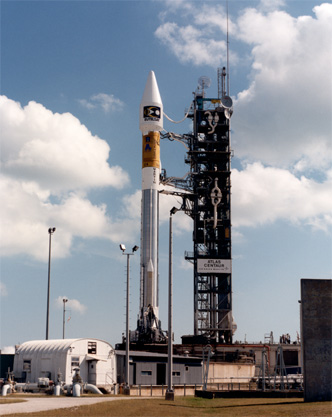
| An Atlas IIA at Complex 36, Pad B |
This picture was provided by Bridget Griffin, an Atlas Launch Operations Engineer. The photo
itself is labeled "U.S. Air Force Photo / 45th Space Wing / RVITS Still Image Laboratory /
Operated by the Bionetics Corporation", with no copyright asserted.
An Atlas IIA awaits launch at Complex 36, Pad B. This particular Atlas IIA, designated AC124, successfully launched on November 21, 1996, carrying into orbit the Eutelsat Hot Bird 2 television satellite.
The MST, which is not visible in this picture, has already been rolled away. Looking closely at the Umbilical Tower, you will notice four connections to the vehicle. The top umbilical provides power, and air or Gaseous Nitrogen (GN2) to the spacecraft. The two booms provide power and propellants to the stages. The bottom arm is a ground wind damper. Both the launch vehicle and the Umbilical Tower stand upon the Launch and Service Building (LSB), a two-story building that serves as a ramp and provides a launch platform.
The Atlas IIA is an improved version of the successful Atlas II launch vehicle. The Atlas booster contains a Rocketdyne MA-5A engine set, which consists of one booster engine (with two thrust chambers) and one sustainer engine. Both engines are powered by RP-1 (kerosene) and LOX (liquid oxygen). The Centaur upper stage contains two Pratt & Whitney RL10A-4 engines. The RL10A-4 is powered by LOX and LH2 (liquid hydrogen). Atop the upper stage is the payload fairing, which contains the satellite or spacecraft. All vehicles in the Atlas II family trace their lineage back to the Atlas ICBM.